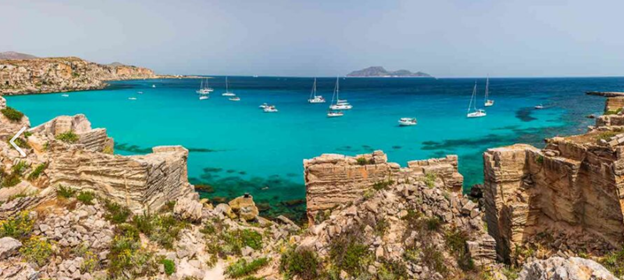
MERGING HERITAGE AND ENERGY INNOVATION IN FAVIGNANA, ITALY
Overview
To support long-term energy planning in insular areas, an analysis was conducted for the Municipality of Favignana, considering local renewable energy (RES) potential, demographic trends, and environmental protection. Three energy scenarios were evaluated: LowRES (business-as-usual approach), RES (moderate renewable integration), and HighRES (full renewable transition). The results indicate that Favignana has significant potential for solar and wind energy generation, heat generation from solar collectors, and with heat pumps and energy storage systems playing a crucial role in balancing the grid. The HighRES scenario demonstrates that a fully renewable energy system is feasible with strong municipal support and strategic investments.To achieve this, the municipality could facilitate the formation of an Energy Community, prioritizing solar Photovoltaic (PV) and wind energy installations. Public buildings should lead by adopting solar collectors for hot water and heat pumps for heating and cooling, coupled with the installation of Electric vehicle (EV) charging stations. Encouraging residential PV adoption and implementing public awareness campaigns on smart charging and Vehicle-to-Grid (V2G) solutions will further support a sustainable energy transition.
Figure 1 Monthly representation of technologies contributing to the power supply in HighRES scenario, with very significant contribution from the vehicles batteries in securing the stability of the system
Socio-Economic Feasibility Analysis
The economic performance of three energy scenarios was analysed using HOMER software, where only the electric generators were modelled, and economic outcomes were derived accordingly. Key indicators assessed include the Levelized Cost of Electricity (LCOE), Annual Worth (AW), Internal Rate of Return (IRR), Return on Investment (ROI), and discounted Payback Period (PbP). The results indicate that as the share of renewable energy sources (RES) increases, the LCOE decreases, from 0.2566 €/kWh in the LowRES scenario to 0.2334 €/kWh in the HighRES scenario, suggesting a potential reduction in electricity prices for consumers. This trend is supported by other economic indicators, with AW rising from 357,275 €/year to 2,428,445 €/year as RES share increases. The IRR follows a slight downward trend, decreasing from 27.9% in the LowRES scenario to 24.2% in the HighRES scenario. However, a higher RES share also leads to an increase in PbP, from 3.63 years to 4.55 years, reflecting the higher initial investment costs associated with these systems. The higher cost of the HighRES scenario implementation is offset by long-term sustainability and energy independence. Additionally, it was determined that public-private partnership can accelerate the adoption of RES technologies as well as that V2G technology enhances grid stability, reducing the need for additional storage investments.
Macro objective:
- Demonstrate the feasible integrated energy system for an insular community, based 100% on locally available renewable energy sources
Specific objectives:
- Use locally available renewable energy
- Decarbonize sectors of energy demand, primarily transport to exploit the synergetic effects provided by vehicles batteries
- Provide socio-economically sound options for the development of an island community
Impacts that could be achieved by 2030:
- CO2 emissions reduced by 12 kt per year due to increased RES adoption
- New RES installations: 4 MW Solar PV, 2.8 MW wind power, heat pumps and solar collectors for heating and cooling
- Local employment benefits: 5 to 9 jobs in RES installation and maintenance, with significant emphasis on the heating solutions
Read more here.
Learn More about the PRISMI Methodology.
Contact
Antun Pfeifer
Technical transferring partner in the PRISMI PLUS project



